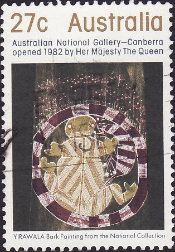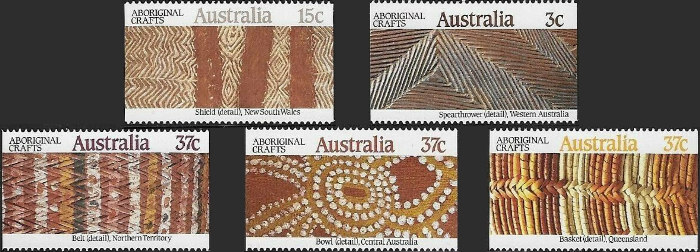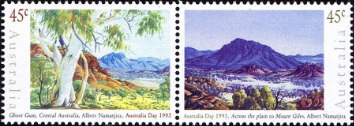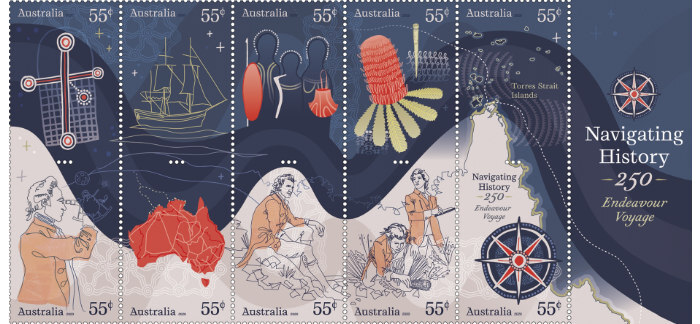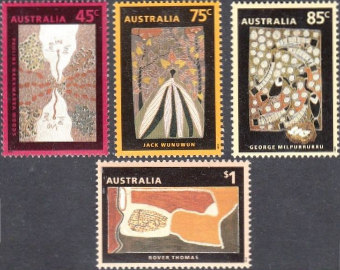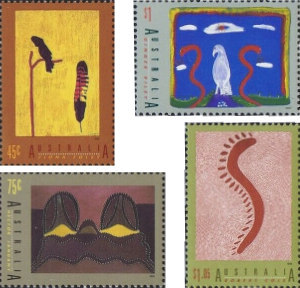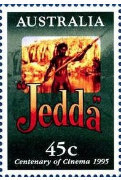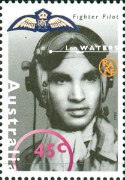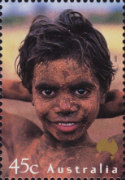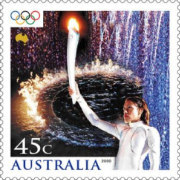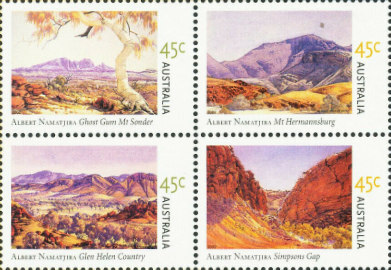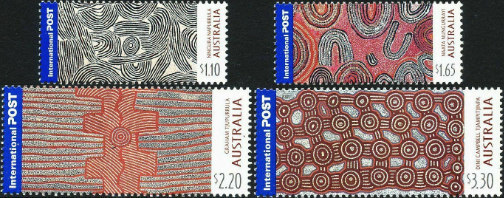Aboriginal timeline: Arts
Found 131 results for your search. Showing page 5 of 7.
2009
-
Kev Carmody is inducted into the Hall of Fame of the Australian Recording Industry Association (ARIA) Music Awards.
1999
-
Jimmy Little is inducted into the Hall of Fame of the Australian Recording Industry Association (ARIA) Music Awards.
2021
-
Simon & Schuster publishes Anita Heiss' novel, Bila Yarrudhang-galang-dhuray (River of Dreams in Wiradjuri), believed to be the first title of any commercial Australian novel appearing solely in an Aboriginal language.
-
For the first time in its 25-year history, the international Australian Fashion Week (31 May – 4 June) opens with a Welcome to Country and features two Aboriginal runways with an all-Aboriginal cast and all-Aboriginal designers, curated by Aboriginal people (runway 1: First Nations Fashion and Design (FNFD), runway 2: Indigenous Fashion Projects (IFP)).
For a long time we've been associated with $4.99 boomerangs. No more please. We are luxury. It is an ancient, beautiful culture that has such depth and beauty.
— Amanda Healy, Wonnarua woman, CEO of Kirrikin (Indigenous Fashion Project) [1]
1988
-
Australia Post issues four stamps celebrating the Art of the Desert. All paintings selected for this issue depict an event in the Dreaming: Bush Potato Country (Turkey Tolsen Tjupurrula & David Corby Tjapaltjarri, 37c), Courtship Rejected (Limpi Puntungka Tjapangati, 55c), Medicine Story (unknown artist, 90c) and Ancestor Dreaming (Tim Leura Tjapaltjarri, $1).

The issue features four stamps from the Flinders University Art Museum that depict an event in the Dreaming.
1982
-

The stamp shows Gurgurr the Moon man, and his dog Mulutji. Australia Post issues a stamp commemorating the opening of the National Gallery, Canberra. The design shows an Aboriginal bark painting of Gurgurr the Moon man, and his dog Mulutji as they appear on the moon. The artist is not mentioned.
-
Australia Post issues a set of four stamps themed Aboriginal Culture in Music and Dance. It is the first time actual Aboriginal work appears on Australian stamps. All designs show bark paintings of Mimi spirits dancing. The artists are David Milaybuma (27c), Lofty Nabardayal (40c), Jimmy Galareya (65c) and Dick Nguleingulei-Murrumurru (75c).

Mimis are fairy-like beings of Arnhem Land (NT) and have extremely thin and elongated bodies. They live in rock crevices and sometimes taunt people.
1984
-
The first stamp issue for the Australian Bicentennial shows Aboriginal rock art. It is interesting to note that the series is titled "First Australians" which only much later was agreed to be one of the appropriate terms for Aboriginal people. The first stamp introduces the bicentennial symbol. Australia Post also published a booklet with detailed explanations of the stamps called The First Australians: Our Heritage in Stamps (Australian Bicentennial Collection).
The designs show stick figures (Cobar Region, NSW), Bunjil's Cave (Grampians, WA), Quirkan Gallery (Cape York, QLD), a Wandjina spirit with snake babies (Gibb River, Kimberley, WA), a rock python (Gibb River), a silver barramundi (Kakadu National Park, Alligator Rivers Area, NT) and a rock possum (Kakadu National Park).


Although the captions use "First Australians" they fail to explain the locations of the rock art, a lost opportunity to raise awareness of this rich cultural heritage.
1987
-
Australia Post issues a set of 5 stamps with details of Aboriginal crafts. The stamps show patterns on a basket (from Arukun, QLD; 37c), a spear thrower (Warburton River, WA; 3c), a bowl (Pintubi people of Central Australia; 37c); a belt (Arnhem Land, NT; 37c) and a shield (New South Wales; 15c).

Aboriginal people used ochres and grasses of different colours to create the patters seen in their craft.
1993
-
To celebrate the International Year of Indigenous People, Australia Post issues two stamps for Australia Day that celebrate Aboriginal painter Albert Namatjira and his watercolour style. The stamps show a ghost gum and Mount Giles.

Albert Namatjira was famous for his use of water colours.
2020
-
A special set of oversized stamps celebrates the 250th anniversary of the Endeavour voyage. The "Navigating History" stamps were designed by Aboriginal artist Jenna Lee and Niqui Branchu from the creative agency Gilimbaa. Each stamp shows how Aboriginal and European narratives overlap in the context of the Endeavour voyage. The themes include sky, land, people, plants and the future. As Australia Post put it, "the visual narrative aims to create respect, insight and understanding of the multiple stories, lives and cultures that intersected at the time of the Endeavour’s Pacific voyage". [2]

The designers used bold red colour to illustrate Aboriginal stories and fine lines for European narratives. Note how the wavy dark blue band could almost represent the rainbow serpent, a key spiritual element in many Aboriginal teachings.
1993
-

The common theme of these paintings is 'Dreaming'. Australia Post issues a set of four stamps to celebrate the International Year of Indigenous People showing paintings by Aboriginal artists. They are: Wild Onion Dreaming by Pauline Nakamarra Woods (45c), Yam Plants by Jack Wunuwun (75c), Goose Egg Hunt by George Milpurrurru (85c) and Kalumpiwarra-Ngulalintji by Rover Thomas ($1).
-

This set showcases the work of four different Aboriginal artists. A second set of stamps celebrates the International Year of Indigenous People with the designs for this issue based on four Aboriginal artists' work: Black Cockatoo Feather by Fiona Foley (45c), Ngarrgooroon Country by Hector Jandany (75c), Ngak Ngak by Ginger Riley Munduwalawala ($1) and Untiled by Robert Cole ($1.05).
1995
-

Jedda was the first Australian feature to employ Aboriginal lead actors. One stamp in the Centenary of Cinema issue features Jedda – the first Australian feature film to use Aboriginal actors in the lead roles and the first to be filmed in colour.
-

Len Waters was a fighter pilot for the RAAF. Streets in ACT and Sydney bear his name. In its second Australia Remembers issue, Australia Post features Len Waters who became the first Aboriginal military pilot accepted into the Royal Australian Air Force and the only Aboriginal fighter pilot to serve during World War II.
1997
-
The stamps in this issue are images from four animations of The Dreaming series, a video series of 13 animated stories for children, released by the Australian Film Commission in 1995 and 1997.
The images show Dumbi the owl (based on a story by David Mowaljarlai of the Hibiscus people), The Two Willy-Willies (a story told by Josie Boyle from the desert people of the Wongi nation), How Brolga Became a Bird (a story told by Pauline McLeod from the Mutti Mutti people of Lake Mungo, NSW) and Tuggan Tuggan (Silky Oak) (a story told by Oodgeroo Noonuccal from Stradbroke Island).

Left to right: Dumbi the Owl; The Two Willy-Willies; How Brolga Became an Owl; Tuggan Tuggan.
2000
-

Portrait of young Cyril Watson. One of the 25 unique photographs of Australians from everyday life in the Faces of Australia issue is Cyril Watson, a young girl from remote Central Australia.
-

The 45c stamp featured Cathy Freeman holding the Olympic torch. This stamp issue features Cathy Freeman lighting the Olympic Flame at the opening ceremony of the XXVII (27th) Olympic Games in Sydney. The stamp was voted the most popular in the 2000 Australia Post Stamp Poll.
2002
-
Australia Post celebrates a centenary since the birth of Aboriginal artist Albert Namatjira on 28 July, 1902. He was the first Aboriginal artist to exhibit his work professionally and paint in a Western style.

Albert Namatjira's signature style features desert landscapes of Central Australia.
2003
-
Australia Post issues a set of stamps that celebrates the Papunya Tula school of art. The set shows four of the many artists: Ningura Napurrula (Pintupi, born c. 1938; $1.10), Naata Nungurrayi (Pintupi, born c. 1932; $1.65), Graham Tjupurrula (Pintupi, born 1975; $2.20) and Dini Campbell Tjampitjinpa (Pintupi, c.1945-2000; $3.30). All paintings are untitled.

The stamps show four paintings of artists of the Papunya Tula art movement.
References
View article sources (0)
[103865] 'The Australia Post Legends 2017: Indigenous leaders', Australia Post 29/5/2017

